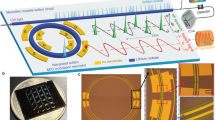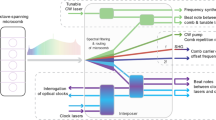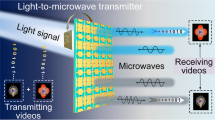Abstract
Optoelectronics could be used to develop fast and wideband information systems. However, the large frequency mismatch between optically synthesized signals and electronic clocks makes it difficult to synchronize optoelectronic systems. We describe an on-chip microcomb that can synthesize single-frequency and wideband signals covering a broad frequency band (from megahertz to hundreds of gigahertz) and that can provide reference clocks for the electronics in the system. Our synchronization strategy, which aligns optically synthesized signals and electronics, can provide signal manipulation precision and data transmission without coherent digital signal processing. To illustrate the capabilities of this approach, we create a wireless joint sensing and communication system based on a shared microcomb-based transmitter.
This is a preview of subscription content, access via your institution
Access options
Access Nature and 54 other Nature Portfolio journals
Get Nature+, our best-value online-access subscription
$32.99 / 30 days
cancel any time
Subscribe to this journal
Receive 12 digital issues and online access to articles
$119.00 per year
only $9.92 per issue
Buy this article
- Purchase on SpringerLink
- Instant access to full article PDF
Prices may be subject to local taxes which are calculated during checkout




Similar content being viewed by others
Data availability
The data used to produce the plots within this paper are available via Zenodo at https://doi.org/10.5281/zenodo.14220282 (ref. 63). All other data used in this study are available from the corresponding authors upon request.
Code availability
The codes that support the findings of this study are available from the corresponding authors upon reasonable request.
References
Luo, T.-N., Wu, C.-H. E. & Chen, Y.-J. E. A 77-GHz CMOS FMCW frequency synthesizer with reconfigurable chirps. IEEE Trans. Microw. Theory Tech. 61, 2641–2647 (2013).
Vankka, J. & Halonen, K. A. Direct Digital Synthesizers: Theory, Design and Applications Vol. 614 (Springer, 2001).
Sengupta, K., Nagatsuma, T. & Mittleman, D. M. Terahertz integrated electronic and hybrid electronic–photonic systems. Nat. Electron. 1, 622–635 (2018).
Torres-Company, V. & Weiner, A. M. Optical frequency comb technology for ultra-broadband radio-frequency photonics. Laser Photonics Rev. 8, 368–393 (2014).
Marpaung, D., Yao, J. & Capmany, J. Integrated microwave photonics. Nat. Photonics 13, 80–90 (2019).
Tetsumoto, T. et al. Optically referenced 300 GHz millimetre-wave oscillator. Nat. Photonics 15, 516–522 (2021).
Jørgensen, A. A. et al. Petabit-per-second data transmission using a chip-scale microcomb ring resonator source. Nat. Photonics 16, 798–802 (2022).
Idjadi, M. H. & Aflatouni, F. Integrated Pound–Drever–Hall laser stabilization system in silicon. Nat. Commun. 8, 1209 (2017).
Pasquazi, A. et al. Micro-combs: a novel generation of optical sources. Phys. Rep. 729, 1–81 (2018).
Del’Haye, P., Papp, S. B. & Diddams, S. A. Hybrid electro-optically modulated microcombs. Phys. Rev. Lett. 109, 263901 (2012).
Liu, J. et al. Photonic microwave generation in the X- and K-band using integrated soliton microcombs. Nat. Photonics 14, 486–491 (2020).
Telle, H. R. et al. Carrier-envelope offset phase control: a novel concept for absolute optical frequency measurement and ultrashort pulse generation. Appl. Phys. B 69, 327–332 (1999).
Jones, D. J. et al. Carrier-envelope phase control of femtosecond mode-locked lasers and direct optical frequency synthesis. Science 288, 635–639 (2000).
Del’Haye, P. et al. Phase-coherent microwave-to-optical link with a self-referenced microcomb. Nat. Photonics 10, 516–520 (2016).
Lucas, E. et al. Ultralow-noise photonic microwave synthesis using a soliton microcomb-based transfer oscillator. Nat. Commun. 11, 374 (2020).
Yao, X. S. & Maleki, L. Optoelectronic microwave oscillator. J. Opt. Soc. Am. B 13, 1725–1735 (1996).
Hao, T. et al. Breaking the limitation of mode building time in an optoelectronic oscillator. Nat. Commun. 9, 1839 (2018).
Maleki, L. The optoelectronic oscillator. Nat. Photonics 5, 728–730 (2011).
Fortier, T. M. et al. Generation of ultrastable microwaves via optical frequency division. Nat. Photonics 5, 425–429 (2011).
Li, J., Yi, X., Lee, H., Diddams, S. A. & Vahala, K. J. Electro-optical frequency division and stable microwave synthesis. Science 345, 309–313 (2014).
Li, J., Lee, H. & Vahala, K. J. Microwave synthesizer using an on-chip Brillouin oscillator. Nat. Commun. 4, 2097 (2013).
Ghelfi, P. et al. A fully photonics-based coherent radar system. Nature 507, 341–345 (2014).
Newman, Z. L. et al. Architecture for the photonic integration of an optical atomic clock. Optica 6, 680–685 (2019).
Kittlaus, E. A. et al. A low-noise photonic heterodyne synthesizer and its application to millimeter-wave radar. Nat. Commun. 12, 4397 (2021).
Kudelin, I. et al. Photonic chip-based low-noise microwave oscillator. Nature 627, 534–539 (2024).
Brodnik, G. M. et al. Optically synchronized fibre links using spectrally pure chip-scale lasers. Nat. Photonics 15, 588–593 (2021).
Hyun, M., Chung, H., Na, W. & Kim, J. Femtosecond-precision electronic clock distribution in CMOS chips by injecting frequency comb-extracted photocurrent pulses. Nat. Commun. 14, 2345 (2023).
Zhou, Z. et al. Communications with guaranteed bandwidth and low latency using frequency-referenced multiplexing. Nat. Electron. 6, 694–702 (2023).
Zhao, Y. et al. All-optical frequency division on-chip using a single laser. Nature 627, 546–552 (2024).
Sun, S. et al. Integrated optical frequency division for microwave and mmWave generation. Nature 627, 540–545 (2024).
Liang, W. et al. High spectral purity Kerr frequency comb radio frequency photonic oscillator. Nat. Commun. 6, 7957 (2015).
Bao, H. et al. Laser cavity-soliton microcombs. Nat. Photonics 13, 384–389 (2019).
Cutrona, A. et al. Stability of laser cavity-solitons for metrological applications. Appl. Phys. Lett. 122, 121104 (2023).
Kippenberg, T. J., Holzwarth, R. & Diddams, S. A. Microresonator-based optical frequency combs. Science 332, 555–559 (2011).
Jin, W. et al. Hertz-linewidth semiconductor lasers using CMOS-ready ultra-high-Q microresonators. Nat. Photonics 15, 346–353 (2021).
Spencer, D. T. et al. An optical-frequency synthesizer using integrated photonics. Nature 557, 81–85 (2018).
Del’Haye, P., Beha, K., Papp, S. B. & Diddams, S. A. Self-injection locking and phase-locked states in microresonator-based optical frequency combs. Phys. Rev. Lett. 112, 043905 (2014).
Shen, B. et al. Integrated turnkey soliton microcombs. Nature 582, 365–369 (2020).
Chang, L., Liu, S. & Bowers, J. E. Integrated optical frequency comb technologies. Nat. Photonics 16, 95–108 (2022).
Li, J. et al. Ultrahigh-factor frequency multiplication based on optical sideband injection locking for broadband linear frequency modulated microwave generation. Opt. Express 29, 40748–40758 (2021).
Liu, C. et al. Investigation of signal-to-noise ratio performance of microwave photonic links enhanced by optical injection locking and channelized spectrum stitching. Opt. Express 30, 19731–19744 (2022).
Tsai, C.-T. et al. Long-reach 60-GHz MMWoF link with free-running laser diodes beating. Sci. Rep. 8, 13711 (2018).
Yu, J. et al. Broadband photon-assisted terahertz communication and sensing. J. Lightwave Technol. 41, 3332–3349 (2023).
Zheng, X., Xue, Z., Li, S., Xue, X. & Zhou, B. Photonics-assisted joint radar and communication system based on optoelectronic oscillator. Opt. Express 29, 22442–22454 (2021).
Xue, Z. et al. OFDM radar and communication joint system using opto-electronic oscillator with phase noise degradation analysis and mitigation. J. Lightwave Technol. 40, 4101–4109 (2022).
Younis, M., Metzig, R. & Krieger, G. Performance prediction of a phase synchronization link for bistatic SAR. IEEE Geosci. Remote Sens. Lett. 3, 429–433 (2006).
Minn, H., Bhargava, V. & Letaief, K. A robust timing and frequency synchronization for OFDM systems. IEEE Trans. Wirel. Commun. 24, 822–839 (2003).
Nasir, A. A., Durrani, S., Mehrpouyan, H., Blostein, S. D. & Kennedy, R. A. Timing and carrier synchronization in wireless communication systems: a survey and classification of research in the last 5 years. EURASIP J. Wirel. Commun. Netw. 2016, 180 (2016).
Shu, H. et al. Microcomb-driven silicon photonic systems. Nature 605, 457–463 (2022).
Zhang, Z., Liu, Y., Stephens, T. & Eggleton, B. J. Photonic radar for contactless vital sign detection. Nat. Photonics 17, 791–797 (2023).
Behravan, A. et al. Positioning and sensing in 6G: gaps, challenges, and opportunities. IEEE Veh. Technol. Mag. 18, 40–48 (2023).
Sanjari, P. & Aflatouni, F. An integrated photonic-assisted phased array transmitter for direct fiber to mm-wave links. Nat. Commun. 14, 1414 (2023).
Skolnik, M. I. (ed.) Radar Handbook, 3rd edn (McGraw-Hill, 2008).
Koivumäki, P. Triangular and Ramp Waveforms in Target Detection with a Frequency Modulated Continuous Wave Radar. Master’s thesis, Aalto Univ. (2017).
Huang, G. et al. Thermorefractive noise in silicon-nitride microresonators. Phys. Rev. A 99, 061801 (2019).
Lao, C. et al. Quantum decoherence of dark pulses in optical microresonators. Nat. Commun. 14, 1802 (2023).
Savchenkov, A. et al. Stabilization of a Kerr frequency comb oscillator. Opt. Lett. 38, 2636–2639 (2013).
Martinez, G. D. et al. A chip-scale atomic beam clock. Nat. Commun. 14, 3501 (2023).
Reed, G. T., Mashanovich, G. Z., Gardes, F. Y. & Thomson, D. J. Silicon optical modulators. Nat. Photonics 4, 518–526 (2010).
Boes, A. et al. Lithium niobate photonics: unlocking the electromagnetic spectrum. Science 379, eabj4396 (2023).
Zhang, X. et al. High-coherence parallelization in integrated photonics. Nat. Commun. 15, 7892 (2024).
Li, K. et al. An integrated CMOS–silicon photonics transmitter with a 112 gigabaud transmission and picojoule per bit energy efficiency. Nat. Electron. 6, 910–921 (2023).
Zhang, X. et al. Microcomb-synchronized optoelectronics. Zenodo https://zenodo.org/records/14220282 (2024).
Acknowledgements
We thank J. Yang, Q. Sun, Z. Mo, W. Jiang, Z. Yin and Q. Xie for fruitful discussions and helpful comments on the paper and H. Shu and Z. Tao for supplying the large-bandwidth PD. This work is supported by High-Performance Computing Platform of Peking University.
Author information
Authors and Affiliations
Contributions
The concept of this work was conceived by Xiangpeng Z., L.C. and W.L. The experiments were performed by Xiangpeng Z., Xuguang Z. and Y.C. with the assistance of Z.Z., C. Liu, C. Lao, J.D., W.M., J.H., W.J., W.H. and X.W. The results were analysed by Xiangpeng Z., Xuguang Z., Y.C., L.C. and Z.Z. All authors participated in writing the paper. The project was supervised by L.C., Xiangpeng Z., W.L. and J.E.B.
Corresponding authors
Ethics declarations
Competing interests
The authors declare no competing interests.
Peer review
Peer review information
Nature Electronics thanks Xu Yi and the other, anonymous, reviewer(s) for their contribution to the peer review of this work.
Additional information
Publisher’s note Springer Nature remains neutral with regard to jurisdictional claims in published maps and institutional affiliations.
Supplementary information
Supplementary Information
Supplementary Sections, Figs. 1–14 and Table 1.
Rights and permissions
Springer Nature or its licensor (e.g. a society or other partner) holds exclusive rights to this article under a publishing agreement with the author(s) or other rightsholder(s); author self-archiving of the accepted manuscript version of this article is solely governed by the terms of such publishing agreement and applicable law.
About this article
Cite this article
Zhang, X., Zhang, X., Chen, Y. et al. Microcomb-synchronized optoelectronics. Nat Electron 8, 322–330 (2025). https://doi.org/10.1038/s41928-025-01349-7
Received:
Accepted:
Published:
Issue date:
DOI: https://doi.org/10.1038/s41928-025-01349-7
This article is cited by
-
Lighting up the clock rate in electronics
Nature Electronics (2025)



